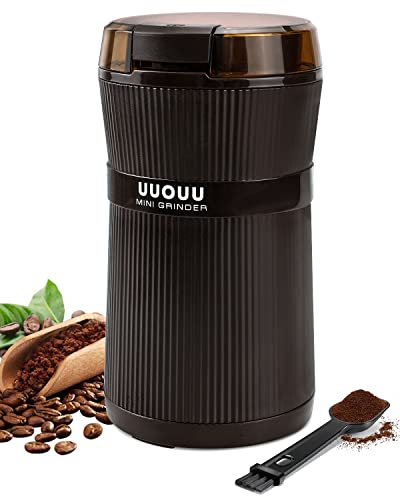



Foro
About Me
Choosing an Espresso Coffee Grinder
Espresso requires a very fine, consistent coffee machine and grinder grind. Many people are focused on the espresso machine or the quality of the beans, but the quality of the grinder is just as important.
A stepless adjustment knob allows you to make micro adjustments with precision. This is preferred over a stepped adjustment which may contain numbers or hashes that mark your desired grinding degree.
Type of Burrs
The type of burrs that a grinder uses is one of the most important factors to take into consideration when selecting an espresso coffee grinder. Espresso grinders feature stronger motors and an additional set of burrs to create a finer ground. This is essential for producing high-quality espresso. Traditional grinders for pour over, drip, or French press are not suitable for espresso brewing because they don't grind the electric coffee grinder beans well enough.
Conve-shaped burrs and flat burrs are the two most popular kinds of grinders organic coffee beans. Both have advantages and disadvantages however, it really depends on your brewing style and preferences. Flat burrs typically have a more consistent grind, which can lead to a cleaner and clearer cup of coffee. However, they do generate more heat during grinding and leave stragglers in the grind which can affect the flavor of your espresso.
Conical burrs on the other hand, can be used to accommodate a wider variety of grind sizes. From coarse for French presses, to extremely fine for Espresso. They are also easier to clean than flat burrs.
There is some debate as to whether flat or conical burrs are more suitable for espresso, but this is mostly a matter of individual preference and the kind of coffee you're making. Anecdotal evidence suggests that flat burrs have a clearer flavor, whereas conical burrs have a greater body. However, this is not always the situation. The specific grind size and RPM (revolutions per minute) of a mill can have a significant influence on the flavor taste.
 While the type of burrs can have an impact on the overall grind quality It's important to remember that other factors can have as significant an impact. For example the motor's RPM may create heat that can alter the taste of your coffee. The level of noise generated by the grinder and the grind retention can also have a major impact on the quality of espresso. These factors are typically more influenced by the grinder's motor than its type of burrs.
While the type of burrs can have an impact on the overall grind quality It's important to remember that other factors can have as significant an impact. For example the motor's RPM may create heat that can alter the taste of your coffee. The level of noise generated by the grinder and the grind retention can also have a major impact on the quality of espresso. These factors are typically more influenced by the grinder's motor than its type of burrs.
The Burrs' Size
The size of the burr is a major aspect in the quality of espresso. The finer the grind, the larger burrs. Smaller burrs produce a coarser, less suitable grind for espresso. The size of the burrs can also affect how quickly the grinder grinds coffee. Larger burrs will require a larger motor, and they can be loud. However, they will grind faster and produce a lot less heat. Less heat can result in less variation with the size of the grind, and an easier extraction.
The shape of the burrs may also impact how the beans are ground. For instance, flat burrs can provide a more consistent grind than conical burrs. They also are known to be quieter than conical ones, but this could depend on the motor of the grinder and other factors.
If you decide to purchase an abrasive grinder that is flat, it is essential to choose one that is made of high-quality design and materials. These will help reduce the friction that can cause the grounds to get stuck and generate static electricity inside the niche grinder. They will also reduce the amount of heat produced when grinding, which can affect the quality of the espresso.
Choose a flat burr mill made of a durable material such as titanium or stainless coffee grinder steel. These types of materials are tough and resistant to heat buildup during grinding. They will also be less difficult to clean and withstand the repetitive pressure that is often placed on the burr grinder during its use.
The type of grinder that you select will have an impact on the quality and flavor of your espresso. The burrs have to be aligned correctly so that they do not overlap or hit each other. This could lead to an uneven size of the ground and could harm the grinder. If you observe that the burrs are not aligned correctly it could be necessary for you to seek out a professional.
As time passes, if your grinder is used frequently the burrs could become misaligned. This can result in the formation of a ridge which can alter the consistency and quality of your espresso. If this happens, it's an ideal idea to replace the burrs with one that is specifically designed to fit the grinder you have. SSP's 64 mm Unimodal Red Speed burr sets, for example, can be used to replace the original burrs of many popular espresso focused grinders, like the Mazzer Super Jolly and the Option-O Lagom P64.
The Weight of the Burrs
While it's beneficial to think about burr size and shape however, the weight of the burrs is crucial. The heavier the burrs, more force is exerted by the grinder on the coffee beans. This will affect the grinding rate and, ultimately the size of the particles produced.
The size of the burrs as well as their weight determines how fine a grind is produced. In general, a more fine grind will result in a larger particle size distribution, while the coarser grind will result in smaller sizes of particles. This is the reason it's important to know the function of the burrs when selecting a coffee grinder.
A high quality burr grinder will result in a more uniform particle size distribution, which is essential to ensure constant extractions. The more precise the burrs are the more likely it is that they will wear out over time. A dull burr won't cut the coffee beans in a precise manner - it will squish them which could cause increased the amount of clogging, as well as more heat buildup, and slower grinding rates.
It is normal for burrs to wear down however a grinder that has burrs of poor quality can quickly become unreliable. This is especially true for a commercial coffee grinder that will be heavily used. It is important to maintain a grinder that is of high quality.
You can test the effectiveness of a grinder by running a sample fresh beans, or roasting beans through it. Take a look at the results with your hand. If they're all over the place, you should be aware that it is time to replace your burrs. This will not only improve your drinks but also help extend the life of your grinder and ensure it continues to perform at its best.
Burrs can be adjusted. Burrs
It is crucial to choose a grinder that will produce an evenly distributed grind size. This will allow you to make espresso shots with a consistent and balanced flavor every time.
To accomplish this, select a grinder that has an adjustable upper burr. This allows you to modify your grind. The ability to adjust the burrs can also aid in ensuring consistency, since you can easily alter the amount of fine or coarse coffee is grind.
The ability to adjust the upper burr is usually achieved by turning the lock ring which keeps the upper burr in place. This ring can be rotated clockwise to produce more fine grinds and counterclockwise for more coarse grind. This is particularly useful for setting your grinder to the proper size for espresso. It is essential to be aware of how fine the grind is prior to making coffee as it can affect the flavor of espresso.
Some prefer a finer grind for their espresso because it imparts more flavor to the shot and also reduces the flow of water which is required to make espresso shots. A coarser grind is more difficult to use since it could clog your portafilter basket.
Therefore, it is recommended to choose a coarse or medium grind when using your espresso grinder for coffee. You can utilize the lock ring to quickly switch between these two sizes and allow you to swiftly alter your espresso grinder to meet your specific brewing needs.
When choosing an espresso machine it is crucial to consider the noise level. You should select a grinder that is quiet but not too silent because this could negatively impact the quality of your espresso. The best way to determine the noise level is by placing your ear against the grinder and listen for a humming sound. If you hear a humming sound, you should consider another grinder since it is too loud for you to use.
Location
Occupation
Latest Post: Nuevo Testamento Our newest member: julietchavers5 Recent Posts Unread Posts Tags
Forum Icons: Forum contains no unread posts Forum contains unread posts
Topic Icons: Not Replied Replied Active Hot Sticky Unapproved Solved Private Closed



